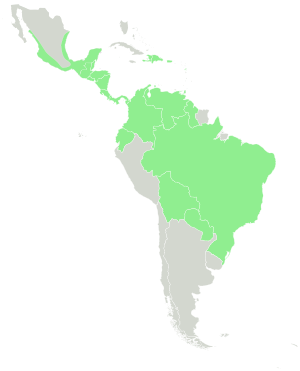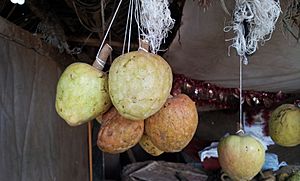Custard apple facts for kids
Quick facts for kids Custard apple |
|
|---|---|
 |
|
| Custard apple fruit | |
| Conservation status | |
| Scientific classification | |
| Genus: |
Annona
|
| Species: |
reticulata
|
 |
|
| Native range of A. reticulata | |
| Synonyms | |
|
Annona lutescens Saff. |
|
| Nutritional value per 100 g (3.5 oz) | |
|---|---|
| Energy | 423 kJ (101 kcal) |
|
25.2 g
|
|
| Dietary fiber | 2.4 g |
|
0.6 g
|
|
|
Protein
|
1.7 g
|
| Vitamins | Quantity
%DV†
|
| Thiamine (B1) |
7%
0.08 mg |
| Riboflavin (B2) |
8%
0.1 mg |
| Niacin (B3) |
3%
0.5 mg |
| Pantothenic acid (B5) |
3%
0.135 mg |
| Vitamin B6 |
17%
0.221 mg |
| Vitamin C |
23%
19.2 mg |
| Minerals | Quantity
%DV†
|
| Calcium |
3%
30 mg |
| Iron |
5%
0.71 mg |
| Magnesium |
5%
18 mg |
| Phosphorus |
3%
21 mg |
| Potassium |
13%
382 mg |
| Sodium |
0%
4 mg |
| Other constituents | Quantity |
| Water | 71.5 g |
|
Link to USDA Database entry
|
|
| †Percentages estimated using US recommendations for adults. | |
The custard apple (also known as Annona reticulata) is a small tree that can lose its leaves in some seasons or stay green all year. It belongs to the Annonaceae plant family. This tree is famous for its sweet fruit, which is also called a custard apple. Other fruits like the Cherimoya and Sugar apple share this name. Sometimes, people also call it "ox heart" or "bullock's heart" because of its shape. The fruit is sweet and often used in desserts.
Contents
What Does a Custard Apple Tree Look Like?
This tree is usually small, growing about 8 to 10 meters (26 to 33 feet) tall. It has an open, uneven shape.
Its long, thin leaves are smooth and pointed at the end. They are about 10 to 20 centimeters (4 to 8 inches) long and 2 to 7 centimeters (1 to 3 inches) wide. The flowers are yellowish-green and grow in groups of three or four. Each flower is about 2 to 3 centimeters (1 inch) across. They have three long outer petals and three very tiny inner ones.
The fruits come in different shapes, like heart-shaped, round, or irregular. They are usually 7 to 12 centimeters (3 to 5 inches) big. When the fruit is ripe, it turns brown or yellowish, sometimes with red spots. The skin can look a bit like a net, depending on the type. The inside of the fruit can be juicy and smell nice, or sometimes it can be hard. The taste is sweet and pleasant, much like a creamy custard.
Where Do Custard Apples Grow?
The custard apple tree might have first grown in the Caribbean and Central America. Now, you can find it all over the tropical parts of the world. It grows well in places with wet and dry seasons, from sea level up to about 1,500 meters (4,900 feet) high.
It is grown and has spread naturally in many warm places. These include Southeast Asia, Taiwan, India, Pakistan, Australia, and Africa. In India, it has even moved from farms into the wild.
What Kind of Climate Does It Need?
Custard apple trees grow best in tropical weather. However, they can also be found in subtropical areas. They need a lot of moisture, meaning medium to high rainfall. Compared to other similar fruits, they don't handle dry weather as well.
The best temperature for them is between 17 and 27 degrees Celsius (63 to 81 degrees Fahrenheit). They can handle light frost down to -2 degrees Celsius (28 degrees Fahrenheit). These trees can grow in many types of soil, from slightly acidic to slightly alkaline. They do not like too much water around their roots or very high water tables.
How Are Custard Apples Grown?
You can grow custard apple trees from seeds. Other ways to grow them include grafting (joining parts of two plants) and budding (joining a bud from one plant to another). A single tree can produce about 45 kilograms (100 pounds) of fruit each year. In Asia, the fruit season is from July to September. In the Caribbean, it's from February to April.
How Are Custard Apples Used?
Eating the Fruit
You can eat custard apples fresh, right off the tree. They are not as popular as sugar apples or cherimoyas for eating raw. People also use them to make juices, ice cream, or puddings. In India, they are sometimes cooked into a sauce.
Growing Other Plants
A. reticulata can be grown in home gardens, even if it's not as popular as the sugar apple. It is very useful as a base plant (called a rootstock) for growing better types of Annona trees, especially in humid places. It is also important for creating new hybrid plants by mixing different types.
Other Uses for the Tree
The leaves and branches of the custard apple tree can be used for tanning, which means treating animal skins to make leather. This is because they contain blue colors. The inner bark can be used to make wrappers, decorations, and hats. The wood is soft and can be used to make tools, but it is not very strong.
Nutritional Information
A 100-gram serving of raw custard apple has about 101 calories. It provides a good amount of vitamin C (23% of what you need daily) and vitamin B6 (17% of what you need daily). It is mostly water (72%), with carbohydrates (25%), protein (2%), and fat (1%).
Are There Any Risks?
The Annona reticulata can sometimes spread easily and become an invasive plant. This means it can grow in new places and take over. It's important to know that all parts of the tree, except for the fruit, can be toxic. This means they are not safe to eat and could cause problems if consumed.
Diseases and Pests
Custard apple trees can get several diseases. These include Anthracnose, leaf spot, diplodia rot, and black canker. Small worms called nematodes and tiny insects like mealybugs can also harm the plant.
What Makes It Smell Good?
The nice smell of the custard apple comes from about 180 different natural chemicals. Some of these are called alpha-pinene, myrcene, and limonene. The plant also has a lot of tannins, which are natural compounds.
Traditional Medicine Uses
For hundreds of years, people have used the dried fruits, bark, or leaves of the custard apple tree in traditional medicine practices.
See also
 In Spanish: Annona reticulata para niños
In Spanish: Annona reticulata para niños




